There is a lot Going On, Always Was
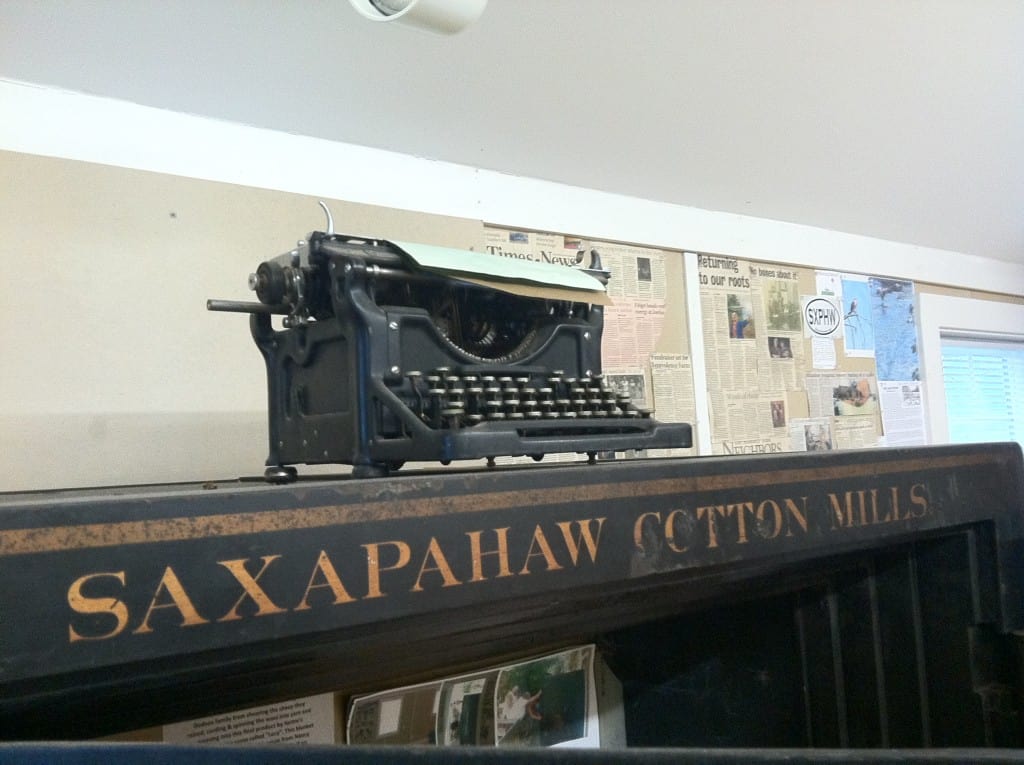
Each season brings updates and more to make, including the opening of the new Saxapahaw Island Park. Rob Greenberg and his Hawbridge Science students, also making up the Earth & Sky Trail Club, have exciting plans for a two-year project creating multimedia trail-markers telling the area’s history and educating nature-lovers about the Sax culture through time.
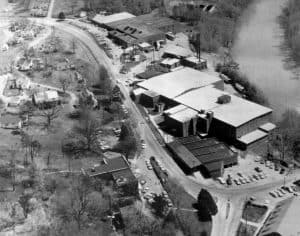
The mill itself is full of stories. In the 8th century, Thomas Thompson built a grist mill on the Haw River at Saxapahaw; about 60 years later that mill was sold to John Newlin and his two sons, who established a cotton factory (1844). This was the year before Alamance County was formed from Orange County, before the Post Office opened its doors. In 1873 the cotton and grist mills (and more) were sold to Edwin Holt. Between 1880-1917 Holt and his company doubled the size of Newlin’s mill. Churches “sprang up” to serve the community members. In 1924 the White Williamson company, then the current owners, closed and a group of buyers, including B. Everett Jordan, purchased the company’s assets and incorporated as Sellers Manufacturing Company, a spinning mill, in 1927. Schools were founded, the River dam was upgraded, a still-active Boy Scouts’ troop began (1941), and, as pictures and memories attest, the 100-year-flood (1948) washed out the island and left its signature in the mill, the church, and beyond. In 1951-52 the dyeing mill, community center, and Ben E. Jordan (Jr.)’s home were built. More growth came, new cattle breeds were introduced, and in 1978 the Sellers Manufacturing Company sold the spinning mill and dye house to Dixie Yarns (Chattanooga, Tennessee). Dixie Yarns sold some of the land and company houses to the John Jordan family in 1978. The dye house closed, and the Jordans converted houses on the river’s north side into rentals, where many of our co-workers and friends live today. Other adventurous souls opened businesses, adding their own creative energy to the community.
In 1994 Dixie Yarns closed its operations, and the next year the Jordan family bought the abandoned spinning mill and dye house from Dixie and started renovation of the spinning mill (lower) into living space (75 apartments) and the dye house (upper) into commercial space, including what is now the Hawbridge Charter School (2013).
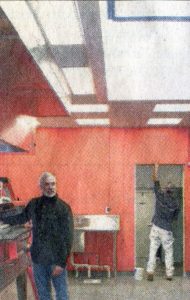
We all experience the challenge of change in some ways every day, visibly and invisibly, so to take the longer view of the history of this mill space, and, in particular, the General Store space is to invite a deeper appreciation of all of the energy and effort that goes into such a “re-framing” that we call renovation. The vision comes first, however faintly.
After another near-100-year-flood, renovation of the upper mill began and the Spinning Mill, Cotton Shed & Boiler Shed entered The National Register of Historic Places (dedicated 1998). Activist Puppets came, the LaGardes seeded, planted and continue to branch out and bloom, and, amidst more hurdles, other businesses (The Eddy, Left Bank Butchery, Volt Salon, Haw River Farmhouse Ales, ShiftWork, and more) made their presence known in this small village. We’re zip lining now through time, to reach the 2008 mark when Jeff and Cameron took over the convenience store that had been known as Poppie’s, and renamed the space The Saxapahaw General Store (the five-star gas station!).
Great tidbits of history help illustrate the “if-these-walls-could-talk” reality of the space that is now the SGS:
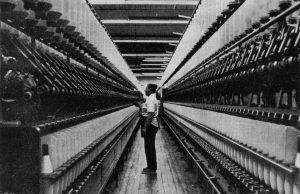 An article in the May 8, 1972 Knitting Times announced the Sellers Manufacturing Company’s creation of a new yarn they dubbed Saxspun. This yarn was produced in what was then a brand new mill equipped with the latest machinery for processing worsted-spun yarns. The article includes several pictures highlighting the new high-tech machines. These machines were housed in what is now the General Store space. How perfectly the ideas come to life here in this village when we stop to look: a mill where yarn was spun, where fabric’s value was daily fare, where seeds were and are sown, of plants and the river and its native history and generations of living souls. Styles come and go. Saxspun lives on, in new forms.
An article in the May 8, 1972 Knitting Times announced the Sellers Manufacturing Company’s creation of a new yarn they dubbed Saxspun. This yarn was produced in what was then a brand new mill equipped with the latest machinery for processing worsted-spun yarns. The article includes several pictures highlighting the new high-tech machines. These machines were housed in what is now the General Store space. How perfectly the ideas come to life here in this village when we stop to look: a mill where yarn was spun, where fabric’s value was daily fare, where seeds were and are sown, of plants and the river and its native history and generations of living souls. Styles come and go. Saxspun lives on, in new forms.
Who doesn’t like a good story?
Saxapahaw is a great place for story-telling and I’m sure it has always been. Along with the Saxapahaw Current, there are several good books about this area, including Heather Wallace’s Saxapahaw (part of Arcadia Publishing’s Images of America series preserving and celebrating the history of neighborhoods, towns, and cities); and also local notable Ben Bulla’s 1992 biography, Textile & Politics: The Life of B. Everett Jordan, from Saxapahaw to the United States Senate. (Our own Orin Shepherd, bookseller, says this one is not easy to find, so it’s a keeper!)
Many share memories of growing up in this town or its surrounds, working in the mill or hearing mill stories from relatives or neighbors. Just ask Wally Quakenbush, another multi-generational descendant. Hearing John Jordan’s memories of this timeline is a special treat as he is a true storyteller, an original problem-solver, someone who seems at home with his waders, pets, logging beams, fishing, overseeing projects, enjoying family gatherings, and rubbing shoulders with all kinds. Like his father, John Jordan eases into daily life, and, perhaps like his father, is never unprepared. He makes his own way, and he loves Saxapahaw.
Jordan explains how the family wanted a “convenience store” in the mill renovation, or area, but they did not want to run a store. They put in the gas station, and rented the store space to Steve Meyers, dubbed “Poppie’s,” as he was called by his grandchildren. Steve Meyers was a lineman who had come to the area from Pennsylvania. Poppie’s, unlike Jeff & Cameron’s version of the store, was not known for its “fancy, good food.” Poppie’s was a place, I gather, that celebrated “the hunt,” and offered a place where locals could gather and share stories, buy a hot dog, soda, or some other sundry, along with bait, worms, frozen and fresh. Poppie had a constant canine companion too. (Dogs still frequent the store, just not inside!)
The SGS still has the maple floors, the posts, and, perhaps, the ghosts of flesh and machine that “talk back,” telling their dramatic stories, building on what was to make what is, as the community stretches and grows. Hawbridge kids stream in when school is out in the afternoon, Crochet-and-Complainers settle in on Monday nights, the Catering branch of SGS plans and plots and expertly delivers, menus are created and changed, food is served (mostly locally sourced), creative local products are featured, and people from many places meet, greet, and eat as they compare life notes.
Questions and stories abound and rebound: What happened to Sam the Alligator? And have you seen Saxapahaw Sam, the local four-legged legend? (Hints: look for his picture in the latest Saxapahaw Current, or ask about him at Hawbridge Farmhouse Ales? Who got Jeff and Cameron here? Why did they come? Where or who did the five-star designation come from? Was the General Store the Company Store? When did it close? How many states in these United States are proud to have an image of Saxapahaw Sam, the groundhog you may have seen while pondering the village’s growth, kudzu and all? Most recently, you don’t process animals in-house? Poppie might like that one.
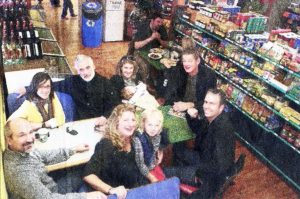
If you’re here, you’re part of the story, so stop by, pull out a chair or slide into a booth. There’s a lot to share. And while you’re here, wish Jeff and Cameron, Store proprietors and jugglers, a happy Store anniversary!
Then visit the Saxapahaw Museum, with its delightful director and caretaker, Jane Cairnes, and learn some juicy history of this little confection called Saxapahaw, magical as ever, and full of the mud, music, memories, laughter, tears, dreams and labor of all who are here and all who tread this ground. We may not have ALL the bells and whistles of big-city life, but the museum has THE old mill whistle, which is being adapted and put back to work. John Jordan spoke about the new project in a recent Times-News interview: “The thought of knowing all the former employees whose workdays were influenced by this whistle inspired the museum to contact Roger Little of Alamance Metal Fabricators to look into whether they could make the whistle blow again. They are in the process of wiring it up so it will have a short whistle at noon Monday through Saturday—not to go to work, but maybe eat at one of the fine restaurants in Saxapahaw.”
A river still runs through it.
